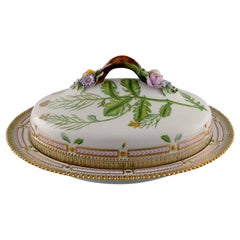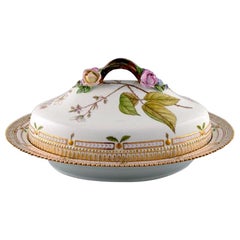Royal Copenhagen Soup Bowl
Recent Sales
20th Century Danish Neoclassical Soup Tureens
Vintage 1960s Danish Neoclassical Soup Tureens
Porcelain
Vintage 1960s Danish Neoclassical Soup Tureens
Porcelain
A Close Look at Neoclassical Furniture
Neoclassical design emerged in Europe in the 1750s, as the Age of Enlightenment reached full flower. Neoclassical furniture took its cues from the styles of ancient Rome and Athens: symmetrical, ordered, dignified forms with such details as tapered and fluted chair and table legs, backrest finials and scrolled arms.
Over a period of some 20 years, first in France and later in Britain, neoclassical design — also known as Louis XVI, or Louis Seize — would supersede the lithe and curvaceous Rococo or Louis XV style.
The first half of the 18th century had seen a rebirth of interest in classical antiquity. The "Grand Tour" of Europe, codified as a part of the proper education of a patrician gentleman, included an extended visit to Rome. Some ventured further, to sketch the ruins of ancient Greece. These drawings and others — particularly those derived from the surprising and rich archaeological discoveries in the 1730s and ’40s at the sites of the Roman cities of Pompeii and Herculaneum — caused great excitement among intellectuals and aesthetes alike.
Neoclassical furniture is meant to reflect both grace and power. The overall appearance of neoclassical chairs, tables and cabinetry is strong and rectilinear. These pieces are, in effect, classical architecture in miniature: chair and table legs are shaped like columns; cabinets are constructed with elements that mirror friezes and pediments.
Yet neoclassicism is enlivened by gilt and silver leaf, marquetry, and carved and applied ornamental motifs based on Greek and Roman sculpture: acanthus leaves, garlands, laurel wreaths, sheaves of arrow, medallions and chair splats are carved in the shapes of lyres and urns. Ormolu — or elaborate bronze gilding — was essential to French design in the 18th and 19th centuries as a cornerstone of the neoclassical and Empire styles.
As you can see from the furniture on these pages, there is a bit of whimsy in such stately pieces — a touch of lightness that will always keep neoclassicism fresh.
Find antique neoclassical furniture today on 1stDibs.
Finding the Right Tureens for You
When you’ve spent hours working on a soup or stew in the kitchen, it deserves nothing less than to be served in an antique or vintage soup tureen.
A large tureen is traditionally used to serve soup or chowder, while smaller tureens can be used to serve sauces. This serving dish is going to be an alluring and practical addition to your collection of serveware. Rather than serving from the hot pot directly from your stovetop, why not elevate the presentation with a tureen on the dinner table?
The word “tureen” comes from the Latin word “terra,” which means earth. This is because potters created the first tureens from ceramics and earthenware. Today, an antique ceramic tureen is going to bring a pop of color to your dining room, as you’ll find that ceramicists traditionally hand-painted their tureens, adorning the sides and lids with natural-world motifs and other decorative embellishments.
Silver tureens, on the other hand, are timelessly understated and will pair with all of your other serving bowls and tableware. We associate certain authentic period furniture with extravagance, and 18th-century serveware, such as Georgian tureens, will likely feature lobing and gadrooning around the body and rim. (Dinner was a big deal during the Georgian era.)
Setting the table should be as important as the meal itself. On 1stDibs, an extensive collection of sophisticated antique and vintage tureens features Victorian tureens, mid-century modern tureens, porcelain tureens and more.

